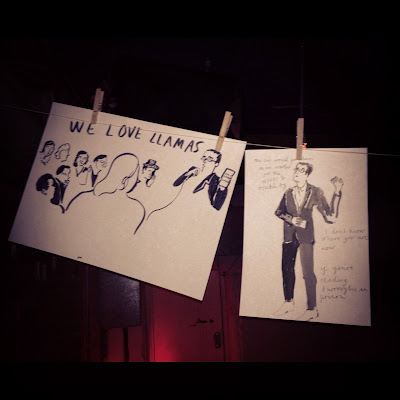Underground Great
Eastern Street in the Victorian Vaults lies a cavern. The air is thick with the too-rich aromas
of tropical plants and suffocating foliage and a tinny
soundtrack of artificial jungle hooting, hisses and clicks fills the space.
Bright jungle-green spotlights pick out a selection of misshapen sculptures and
a large gauze screen which covers the furthest brick wall.
On the screen a large, disembodied head appears. It is Dante the Horticulturalist (complete with green elfish cap and shaving foam beard) and he welcomes us into his realm. 'You-you-you-are how old? I've been doing this for quite a while now---horticulture'. His voice redoubles upon itself - it becomes apparent that there are two voices, one recorded and one live, spoken in the room. The one rolls in and out of sync with the other. But the real-live Dante is nowhere to be seen. And yet, move around the room and you are followed by the eyes of the Horticulturalist - or so it feels. Where is he? Where are we? What are the relationships at play here between installation, environment, artist and audience?
The press release to the show which amassed Dante’s intentions (apparently to achieve pretty much everything possible through art) made for a convoluted bit of supporting literature. But its flowery, overstated language somehow matched the languid heavy hum of the tropical underground which distorted clear thought with its sounds and smells. Dante seems to share the interests of the seminal Swiss artist Pipilotti Rist in playing with physical and psychological relationships produced by bodies inhabiting space. Both artists confuse or merge these initially separate entities in some way so that their boundaries become indistinct...surely the resemblance of Dante’s exhibition’s title to Rist's Eyeball Massage last year at Hayward Gallery cannot be unconscious.
On the screen a large, disembodied head appears. It is Dante the Horticulturalist (complete with green elfish cap and shaving foam beard) and he welcomes us into his realm. 'You-you-you-are how old? I've been doing this for quite a while now---horticulture'. His voice redoubles upon itself - it becomes apparent that there are two voices, one recorded and one live, spoken in the room. The one rolls in and out of sync with the other. But the real-live Dante is nowhere to be seen. And yet, move around the room and you are followed by the eyes of the Horticulturalist - or so it feels. Where is he? Where are we? What are the relationships at play here between installation, environment, artist and audience?
The press release to the show which amassed Dante’s intentions (apparently to achieve pretty much everything possible through art) made for a convoluted bit of supporting literature. But its flowery, overstated language somehow matched the languid heavy hum of the tropical underground which distorted clear thought with its sounds and smells. Dante seems to share the interests of the seminal Swiss artist Pipilotti Rist in playing with physical and psychological relationships produced by bodies inhabiting space. Both artists confuse or merge these initially separate entities in some way so that their boundaries become indistinct...surely the resemblance of Dante’s exhibition’s title to Rist's Eyeball Massage last year at Hayward Gallery cannot be unconscious.
Without a doubt, one to watch. Explore Dante's world here. I especially recommend his radio discussion of cheese.






























